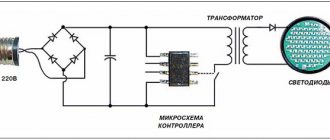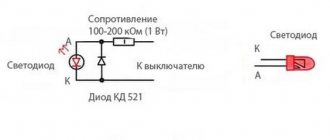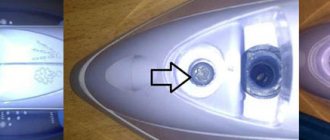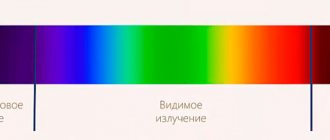The Internet regularly comes across customer complaints about LED lamps that continue to glow dimly or flicker when the lights are off. Atypical behavior of light bulbs is so common that it is useful for any buyer of this product to be aware of it. Let's figure out why an LED lamp burns dimly after turning off, what can cause a similar effect and how to get rid of a non-dangerous but annoying defect.
LED lamps have their own characteristics Source userapi.com
Electrical wiring faults
One of the reasons why LED lamps glow is the natural aging of electrical wiring and the appearance of leaks through the insulation. This can cause tension to appear in completely unexpected places. In most cases it is small, but enough for the LED device to glow faintly.
Old aluminum wiring, laid in a hidden way, after 30 years of operation.
The insulation condition can be checked with a megger (checking with a multimeter in most cases is a waste of time due to the low measuring voltage). For a 220 V network, the insulation resistance should not be less than 0.5 MOhm. But even if a deterioration in the condition of the insulation is detected, often nothing can be done - it is impossible to accurately determine the location of the damage. And since the electrical wiring in residential and public buildings is hidden, its complete replacement is carried out during a major renovation of the premises.
Expert advice
Starikov Mikhail
Senior Electronics Engineer
Ask a Question
When testing the insulation of a 220 V network, the megger voltage should be no more than 500 V. During the measurements, the load (lamp) must be turned off so that it does not fail when exposed to increased voltage. It is also necessary to disconnect the wires under test from the supply side (switch).
Effect of capacitive conductivity
It must be taken into account that the leak may be capacitive in nature. In this case, one plate of the capacitor is a wire, the other is a second wire, a grounded conductive element (fittings), a damp wall, etc. It is much more difficult to detect such a fault with a megger without experience. It must be borne in mind that this problem cannot be solved even by completely replacing the electrical wiring. The capacity will not go away from this, and moreover, it directly depends on the quality of the insulation.
The influence of parasitic capacitance between the neutral and phase wires.
Also, stray capacitance can cause unauthorized glow if there is voltage on the neutral wire relative to ground. Its source is voltage asymmetry in phases, characteristic of end-user networks (220 V). Through the interwire capacitance, this voltage creates a small current, at which the LED lamp lights dimly even when turned off.
And we should also note the influence of interference. There is a situation when another phase wire is laid parallel to a phase wire over a long distance and at a short distance. If a sufficiently powerful load is connected to it, the current flowing through such a conductor creates an electromagnetic field that induces voltage in the LED power wire. It may be enough to constantly or periodically light the LED.
Why does the lamp glow or blink?
One of the most common reasons is the backlight on the switch. LEDs are sensitive to ultra-low currents and interference, and the backlit switch elements allow weak currents to pass through, even when the state is “off”. The second, also very common reason, is that the switch opens zero instead of phase. A broken zero, as a rule, has a capacitive coupling with the surrounding wiring and due to this, parasitic currents arise.
The situation when the switch breaks zero is ubiquitous in Soviet-era wiring. This phenomenon is so common that sometimes it seems as if it was done on purpose. Let me remind you that in the “correct” electrical wiring, the switch must break the phase. A broken zero, by the way, causes the indicator screwdriver attached to it to light up. Similar to an indicator screwdriver, a light bulb sometimes only needs a fraction of a milliamp to produce a faint glow.
Why do some lamps glow dimly and others flicker? This is usually due to the design of the lamp driver, which is hidden in the base. It is believed that a flashing lamp has a better driver, while a smoldering lamp has a cheaper driver. It’s difficult to say about reliability here; both burn out.
If the switch is illuminated
Illumination diagram of the switch and driver input circuits.
Illuminated light switches are popular in everyday life. When the lighting is turned off, a low-power LED (or neon bulb) illuminates the location of the switching element. If the switch is closed, it will bypass the backlight circuit.
As long as incandescent lamps were used, there were no problems. The resistor limited the current to a small level, insufficient for the filament to glow. With the transition to LED lighting, the situation has changed somewhat. The current through the resistor is still not enough to light the LED on its own. But there is a driver at the lamp input. Its input circuits are formed by a rectifier with a smoothing capacitor. The container charges for a long time with a small current, then instantly releases the accumulated charge into the circuit. Visually it looks like periodic LED flashes.
Recommended viewing:
LED lamps, technical characteristics
Having searched the Internet for information about the technical characteristics of LED lamps, I did not find a description of all the characteristics; only the main ones are indicated everywhere. Unlike incandescent light bulbs (which are as simple as 3 rubles), they already contain electronic components, pulse current stabilizers, capacitors, and diode rectifiers. Some modifications may include a motion sensor and remote control. That is, it has become an electronic lighting device suitable for repair.
- 1. Basic parameters
- 2. 1. Luminous flux
- 3. 2. Electricity consumption power
- 4. 3. Light color temperature
- 5. 4. Base type
- 6. 5. Operating temperature range
- 7. 6. Ripple factor
- 8. 7. Degree of protection
- 9. 8. Service life
- 10. 9. Supply voltage
- 11. 10. Case dimensions
Main settings
List of main parameters:
- Light flow;
- Electricity consumption power;
- Color temperature of light;
- Base type;
- Temperature range at which it can operate;
- Ripple factor;
- Degree of protection;
- Life time;
- Supply voltage;
- Dimensions.
Of course, it’s not enough to know the parameters; there are other subtleties. Therefore, you should read my recommendations on how to choose LED lamps for your home.
Light flow
The most important technical characteristic is the luminous flux that it emits, measured in Lumens. In the era of filament light sources, the luminous flux value was practically not used, but was measured by power consumption. Currently, the LED equivalent consumes 10 times less electricity on average.
Previously, incandescent sources provided 12-14 lm per watt, now this value is 80-190 lm per watt. Efficiency depends only on the manufacturer, there are:
- diodes of unknown Chinese production, which give 70-80 lm per W;
- branded Chinese, Japanese, European 110-120 lm per W;
- super bright, often made using COB technology, which give 180-190 lm per watt.
Table of the ratio of LED lamps and incandescent lamps
| Incandescent, W | LED, W | Light Flux, Lumen |
| 40 | 5 | 400 |
| 60 | 8 | 700 |
| 100 | 14 | 1300 |
| 150 | 22 | 2100 |
Electricity consumption power
Energy consumption consists of the consumption of LEDs and the driver. The driver accounts for 1-2 W. If you buy Chinese-made or an unknown domestic manufacturer, then the ice used can often be very poor, usually 3-4 times weaker than branded ones.
Incorrect connection of the lamp
Another reason why LED lights glow may be incorrect connection of the switch and the lamp. If the lamp is connected in such a way that the switch breaks not the phase, but the neutral wire, then when the switching device is turned off, the lamp remains energized, and any leak in the neutral wire leads to the fact that the lamp barely burns or flashes periodically.
Important! This situation is unacceptable from a security point of view. During any repair work there is a risk of receiving an electric shock, even when the switch is turned off.
Briefly about the main thing
The "ghost effect" is a harmless phenomenon, but sometimes it is annoying, and sometimes it signals problems with the home's wiring. You can remove the glow of an LED lamp if you find out why it occurs. A common reason why LED lamps are turned off is a switch with night lighting, long-used wiring, or the design of the device itself.
You should not discount the low quality of the lamp, so focus on products from trusted manufacturers. There are different ways to get rid of problems. When comparing different lamp options, check the proportionality of the parameters (power and radiator). In some cases, you can fix the switch, but sometimes the solution is to replace the wiring.
Low quality LEDs
Contrary to popular belief, the quality of the light-emitting elements is unlikely to be the sole reason why an LED lamp glows on its own after being turned off. Theoretically, cheap LEDs of unknown origin may have low substrate insulation resistance, but this will more likely lead to leakage of current, initiating the glow. Such a defect should be revealed the first time the lamp is turned on during inspection during purchase, and any consumer will refrain from purchasing a lamp with reduced brightness or no glow.
Related video: The lamp shines but not brightly
The ice lamp shines dimly - what to do? — Elektrobaza
LED lamps, of course, occupy a leading place in energy saving among other energy-saving lamps. Moreover, they have many more advantages, for example, a positive effect on the visual system, environmental friendliness, safety, and long service life. But in every barrel of honey there is a fly in the ointment, and ice lamps have one significant drawback - their high price. It's true that LED lighting costs a pretty penny, but in the long run it can save up to 95% of energy, which is very beneficial.
However, when using "housekeepers" some problems may arise, for example, the LED lamp began to shine poorly. A dim stream of light or its flickering makes you regret that a lot of money was given for imaginary savings. However, the reasons for a dim glow are not always the fault of the manufacturer, just like the buyer. Let's look at them in more detail.
Let's clarify the question that concerns you or immediately read the general recommendations for increasing the luminous flux of lamps:
Poor quality of the lamp or its individual components
The peculiarity of LEDs is that the higher their temperature, the dimmer they shine; scientifically speaking, the lower the luminous flux. Up to 50% of the energy consumed by LEDs is converted into heat, and if it is not properly removed, then “the LED kills itself.” Read more about how the individual components of the lamp affect the temperature below.
Solutions:
- Identification and replacement of a low-quality element of the lamp design.
- Buy ice lamps from proven, reliable brands.
- Remove heat from the lamp as much as possible.
Inflated passport data
Many manufacturers deliberately inflate the characteristics indicated on the box and in the passport for advertising purposes. For example, you buy a lamp on which it is written that it replaces a 100 W incandescent lamp, but in fact its luminous flux does not reach even a 60 W lamp. Therefore, you get the impression that the new LED lamp shines dimmer than your 100-watt “Ilyich bulb”.
Solution: buying a new lamp from a trusted brand that writes the truth on the boxes of its lamps. Place a dim lamp in a utility room, hallway or landing.
Installing a lamp in a closed luminaire housing
If you install an LED lamp in a closed lamp, you thereby prevent the lamp from “breathing”. In a closed lampshade, the lamp overheats, and, consequently, the luminous flux will be lower, and the lampshade diffuser itself steals the power of the luminous flux.
Solution: remove the shade from the lamp
Installing the lamp near a heat source
If you installed an LED lamp in a lamp located near or above radiators, a fireplace, a heat convector or a fan heater, you unknowingly reduced the luminous flux and service life of the LED lamp due to its additional heating.
Solution: place the lamp as far as possible from the heat source
Color temperature of light
People perceive the brightness of the color palette differently, including the color temperature of LED lamps. One person may perceive the light intensity differently from two lamps with the same power and luminous flux simply because they have a different color temperature index. 3000-4000K (warm color) is closer to yellow, 5000-6000K (cool color) is closer to white. As a rule, in the second case, it subjectively seems that the lamp shines brighter.
When the LED light is half lit
There is such a thing as a slight glow of a diode lamp after the power has been turned off. There are several explanations for this, some factors relate to electrical safety, and some relate to the functioning of a light source of this type. In any case, to understand why an LED light bulb lights up when there is no load, it is necessary to consider the operating conditions of the lighting device and determine the cause in each specific situation. The design of this type of lamp is more complex than its analogue with an incandescent filament.
How harmful are burning lamps?
As mentioned above, one of the most common problems with LED operation is the inability to completely turn off the light source. The lamps continue to burn at approximately 5% of normal power for several minutes or even hours.
Sometimes dim lighting tires apartment dwellers, but some use dimly lit lamps as night lights.
It is worth adding that the defect does not have a harmful effect on the condition of the wiring, and energy consumption increases extremely slightly, since LEDs consume a small amount of electricity.
All manipulations with wiring, including disconnecting the wire, connecting or replacing parts, must be carried out only after turning off the electric current.
However, experts advise eliminating the problem as soon as possible, since the residual glow of LEDs significantly reduces their service life. In addition, the reasons that cause this phenomenon can lead to serious troubles.
Review of causes of glow
What to do if the LED lamp is on? There are several reasons why, after turning off the lighting device, the LED lamp continues to burn, even dimly or weakly:
- poor-quality insulation in a section of the electrical circuit or any other electrical wiring malfunction;
- the switch to which the LED lamp is connected is backlit;
- low-quality emitters are used in the design of the lighting source;
- special functionality of the lighting element.
Expensive
If you decide to replace your incandescent lamps with LED ones, be prepared to pay up to 10 times more - they are approximately that many times more expensive. And this is their first and main disadvantage.
The high price is compensated by 10-fold energy savings. In addition, LED lamps are much less likely to burn out, which means additional savings on the cost of new replacement incandescent lamps. And don’t forget about your time and a slight headache - remember that you need to buy a light bulb to replace the burnt one, remember what kind of base it has, and it would also be nice to have a spare for that room, but what kind of lamps are needed there?... Etc.
Depending on the mode of use, the payback period may occur as early as 6 months after replacing the lamps with LED ones.
One remark needs to be made here.
Recently, there have been a lot of offers of LED lamps on the market at bargain prices. But don’t delude yourself about this. We bought several of these products, disassembled and tested them and received very disappointing results.
Features of the power supply circuit
There are two schemes for connecting LED lamps:
- with LED driver,
- with power supply.
In the second case, it is necessary to use a current limiting resistor. You can find out the required power when purchasing in a store.
The resistor has the ability to accumulate thermal energy, which is enough to produce a faint glow from extinguished LED lamps.
If we are talking about T8 LED lamps (in the form of a tube), then no additional devices are required to connect them - everything you need is in the lamp itself.
this is interesting! There are LED lights that are specifically designed to accommodate LED bulbs that do not dim when turned off.
If you want to replace an incandescent lamp in a lamp with an LED one, then the voltage on the package should indicate 220 V. Next, we select according to the type of base (for example, E14 or E27 are the most common). To avoid confusion with the size of the base, you can take an old light bulb to the store.
What to do and how to fix the problem
You can eliminate the causes of dim LED lighting yourself or, in some cases, by contacting an electrician.
The problem of poor wiring insulation can be solved by replacing it or re-insulating the damaged area. The location of poor-quality insulation is determined by special devices (homemade or purchased) in this way: within a minute, the maximum voltage is applied to the network and, with the help of special equipment, the location of the current leak is found. If you have no knowledge of electrical engineering, then it is better to trust a specialist.
Big size
This is the second drawback. LED lamps are larger in all respects than conventionally similar incandescent lamps. They are wider, longer, heavier.
The reason for this is technological. Incandescent lamps are not afraid of high temperatures; they can heat up to temperatures of structural failure, when glass or glue ceases to be solid. Therefore, their usual heating to 100-300 degrees has practically no effect on functionality (of course, if we do not touch upon fire safety issues).
On the other hand, LEDs should not get very hot
, because When heated, their efficiency decreases significantly and the process of burning out intensifies - they become dull. Therefore, they need to be cooled, which is why LED lamps have a heat sink. And the higher the lamp power, the larger the radiator will be.
Why does an LED lamp burn at full intensity - features of the design and operation of the lamp
The design of an LED lamp consists of a base, driver, radiator, bulb and board with LEDs. The light source is powered through an alternating electric current network, the voltage of which is reduced by the driver. The radiator is responsible for removing heat from the LED elements - they heat up when the lamp is on. If an LED lamp is used instead of a traditional incandescent or halogen lamp, it is necessary to select the power and brightness corresponding to the previous light sources and luminaire.
These features of the operation of LED lamps make it possible to understand why the LED lamp burns at full intensity. It is worth noting that a frequent search on the Internet that includes the word “in full swing” is incorrect. The correct word to use is “full heat”.
Pros and cons of LEDs
Such products have gained popularity among the population due to a number of positive qualities.
Their main advantage is their efficiency: the lamps have a long service life, which is confirmed by a three-year warranty. In addition, they require a minimal amount of energy to function.
Environmental safety is also an important advantage. LED devices do not emit ultraviolet waves, which can harm living organisms. They are designed without hazardous materials, making them easy to dispose of.
A detailed image of the structure of an LED lamp with the designation of all elements, as well as informative captions that tell about the purpose of the nodes
The disadvantages of LED devices include, first of all, their high cost. It should also be taken into account that their operation has specific features: sometimes the LEDs blink or do not turn off even after the switch is turned off.
These disadvantages are caused by the conservation of charge that accumulates in the capacitor. A weak pulsating current leads to flashing, and a stronger one creates a long-lasting glow.











